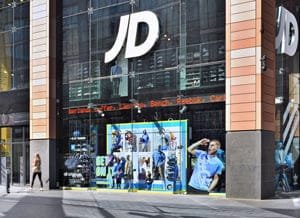Organisations that operate in the business-to-consumer (B2C) market are increasingly turning to market research to support their decision making processes. A retail business, for example, might be considering opening new stores, expanding internationally, proposing to diversify its product range or thinking about acquiring another company. Before proceeding, the business will require specific information to understand the implications of making such changes. The process of collecting this information and developing this understanding is known as market research.

This case study focuses on how JD (part of JD Sports Fashion PLC), the UK’s leading retailer of fashionable sports and leisure wear, uses market research to support and develop its business. As a B2C retailer, JD’s performance depends on providing the most desirable brands and products at the right price and in the right locations to meet with the demands of the consumer.
Founded in 1981 in Mossley, near Manchester, JD today is a nationally recognised UK high street fascia. For 20 years, the business expanded through organic growth, meaning that growth was generated by building sales revenue through increasing its network of stores.
Growth
JD has expanded more rapidly in recent years through acquisitions (inorganic growth), significantly increasing its JD store base through the purchase of First Sport (2002) and All: sports (2005). Through the purchase of Scotts (2004), Bank (2007) and, most recently, Blacks (2012), it has diversified the business into the young branded fashion and outdoor markets.
The Group has also made international acquisitions including Chausport (France), Champion Sports (Ireland) and Sprinter (Spain) as it has expanded its business overseas. The group has also secured brands such as The Duffer of St George, Sergio Tacchini (under UK licence) and the fashion brands Chilli Pepper, Nanny State and Sonneti. The JD Sports Fashion Group now has over 900 stores across the UK and Europe and a reputation for stocking exclusive and stylish ranges.
What is market research?

The exchange between sellers (supply) and buyers (demand) for particular goods or services is called a market. A market does not necessarily exist in a single location, nor need it be a real location – products can be bought and sold online.
Markets change constantly and businesses need to have a clear understanding of both the supply and demand. The principal role of market research, therefore, is to provide a business with a comprehensive view of consumers in order to develop products and services that satisfy their needs better than the competition. Also, given the increased complexity of the business environment, it is no longer enough to make key decisions using a ‘gut-feel’ approach alone. Decisions need to be informed and market research helps to support this process, significantly reducing the level of financial risk attached with investment decisions.
Market research involves the capture and analysis of consumer, competitor and market trend data. This enables JD to assess more accurately the level of demand for its products. It also influences decisions to target capital investment on projects that will offer the best return on that investment, such as opening a new store or entering a new market.

Market research provides consumer feedback. It is essential for JD to have this dialogue with the consumer to gain insight into what they think about its range of products, brands and services. This enables the business to meet its demands and outperform the competition. It helps the business develop a clear and informed strategic business plan which all business colleagues can work towards fulfilling. For example, this information can create a winning marketing mix to target promotions to reach different customer groups or influence decisions on range planning in new stores.
Ansoff’s matrix
Research can also provide information about the size and performance of markets. It can inform a business about who the key competitors are, what they are doing, and their market share. Potential areas of opportunity within an international, national and local context can also be identified. By using tools such as an Ansoff’s matrix to assess the levels of risk, JD can then decide which marketing strategies to focus on.
These are:
- market penetration – winning greater market share in its existing markets
- market development – entering new countries or new retail sectors
- product development – acquiring or developing new products or brands
- diversification – taking the business in a completely new direction.

Primary market research

There are principally two types of market research – primary and secondary. Primary research is sometimes known as field research. This is because it involves gathering data through new research. This data can be collected in either a quantitative or qualitative format.
Quantitative research
Quantitative research is numerically-based and obtains the hard numbers from which decisions can be made with confidence. Examples of quantitative market research at JD include:
- Exit surveys – carried out face-to-face with consumers as they leave the store. This is a simple survey covering a cross-section of stores to gather the views of consumers in different locations and regions. At JD the purpose of the survey is primarily to understand the reasons for visit, frequency of visit/purchase and reasons for and against purchase.
- The ‘shopping bag’ survey – the JD research team monitors what carrier bags customers entering JD stores are carrying. This helps identify what other stores JD customers use and are spending money in. It provides competitor insight and an idea of which retailers attract a similar customer profile to JD, a variable that can influence the location of new JD store openings.
- On-site fieldwork – JD’s dedicated Site Research team invests significant time researching new locations. This involves defining the extent of a location’s catchment area, reviewing the presence and quality of the competition and assessing the pitch and visibility (i.e. how busy the area is) of a unit. This helps build a detailed SWOT analysis of each new site.
Qualitative research
Qualitative information is a primary form of market research which focuses on consumer feelings and opinions on a product or service. This type of research illuminates the facts and figures collected through quantitative research. Examples of qualitative research at JD include:
- Focus groups – by speaking at length with small groups of 8-10 people, more insightful questions can be asked regarding brands and new product developments. At JD these are typically run in schools and colleges, where it can get direct feedback from its core consumers.
- Depth interviews – this involves a researcher accompanying the consumer on a shopping trip in store. This drills deeper into shopper behaviour and their reactions to stores.
When undertaking market research, it is important to reflect the views of all consumers within the business’ target market. However, this would be a huge exercise. One way of managing this is to use sampling methods. Sampling involves taking the responses of a representative group of consumers that are likely to reflect the opinions of the customer base.
Secondary market research

Secondary research is sometimes known as ‘desk research’. This research draws on material that has been collected by another organisation to provide market information. Secondary research data provides a fact based overview of the market. Examples of secondary research include:
- Government census data – the census is conducted every 10 years across the UK and brings together data on factors such as the number of people, their ages and occupations in a location.
- Geo-demographic data – collected by specialist agencies, this segmentation tool profiles consumers based on their lifestage (e.g. marital status, number of children) and their lifestyle (e.g. newspapers read, leisure activities, TV programmes watched).
- Commercial market research reports – prepared by research experts, these provide estimates of the size (volume of sales) in each product or market category and market share by operators within these sectors. At JD this information is invaluable when assessing new product markets (e.g. outdoors) or international opportunities (e.g. France and Spain).
However, there are drawbacks with any form of market research. It costs money to collect and analyse large amounts of information and the results are not always definitive. Numerical data might be biased, particularly if the sample size is too small. Focus groups may be skewed if one member of a focus group is too dominant and stops others from voicing their opinions.
Market research at JD

The location of stores is a critical element of the success of a retailer in any market. Sound competitive locations can provide a source of competitive advantage. To achieve this it is essential to build a clear understanding of the consumer and how they interact with a retailer and its sales channels (i.e. stores, internet or kiosks).
Check-out survey
So, how does JD build up information about its consumers and develop a clear location strategy? One method employed by the company is its check-out survey. This is a simple but highly effective survey that is carried out with customers at the till. By collecting the customer’s home postcode, gender and age and matching this data to the products purchased, JD can build up detailed consumer profiles.
JD also asks purchasers a further question: has the item been purchased for yourself or for another person? This helps JD to understand the difference between customers (the purchaser) and its consumers (the end user). For example, some purchases are made by parents buying clothes or shoes for their children. This additional question helps prevent the survey results from being misinterpreted.
The survey is carried out annually over a two-week period and involves over 350,000 customers. This provides a robust sample from which to extract invaluable insights into consumer buying behaviour. In-depth analysis of the survey results helps the company:
- understand how far customers travel to stores – this enables JD to define real catchment areas for each store and understand the overlap with other existing stores
- build consumer profiles by gender, age, brand and lifestyle
- identify and quantify new store location opportunities
- influence product ranges to meet the buying habits of customers in different locations
- assist with marketing strategies to target the consumer more effectively.

This type of information is collected regularly by large retailers such as supermarkets through the data collected on their store loyalty cards. However, loyalty card schemes can be very expensive to run. Till surveys, although only providing a snapshot of the consumer, offer a cost effective means of gathering data. JD is relatively unique on the high street in using this type of survey to capture additional customer information. More recently this survey has been replicated across JD stores in France and Spain.
Evaluating data
It is important that research is properly managed to ensure that the data collected is valid and reliable. It is also useful, where practical, to use a variety of methods to validate research findings. At JD the findings from the exit surveys (smaller sample sizes) are validated by the check-out survey (larger sample size). Put together, this information helps JD to anticipate the level of demand customers may have for its products. Sales expectations can be accurately forecast to ensure profitable stores are opened.
JD has also embraced the internet as a means to support business strategies. The data collected through the online ordering process is ‘live’ information and it provides a valuable insight into consumer demand. It can influence store ranges and support decisions about its stores network by highlighting ‘hotspots’ with high levels of demand but no physical presence. In an increasingly multi-channel world, capturing, analysing and acting on this information offers a business a key competitive advantage. Again, this information can provide useful insight into potential international opportunities.
Conclusion

In recent years, the UK retail industry has faced challenging conditions. However, against this tough economic backdrop, JD has managed to maintain growth through a thorough understanding of market opportunities.
Market research is not a one-off process. Markets change and a business like JD needs to evaluate customer trends and monitor competitors on a regular basis in order to remain competitive.
JD has therefore established research mechanisms to provide ongoing feedback. These provide a mix of qualitative and quantitative market data obtained directly from consumers and from published research. By understanding its consumer base, JD has established itself as the market leading retailer of fashionable sports and leisure wear.
